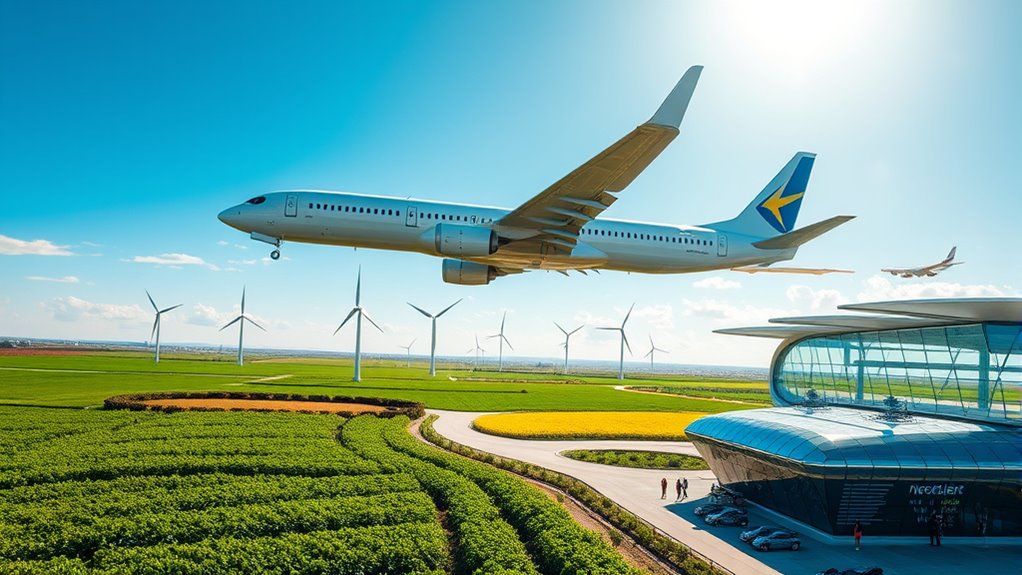By 2025, biofuel flights are becoming more common as airlines adopt sustainable fuels like algae-based and waste-derived options. Major airlines are investing in biofuel technology, retrofitting older planes, and forming partnerships to boost supply. Advances in catalysts and engine design improve efficiency while supporting stricter environmental goals. Although costs and infrastructure challenges remain, ongoing industry progress promises cleaner, greener flights. Explore further to see how these innovations are shaping your eco-friendly travel choices.
Key Takeaways
- Increasing airline commitments aim for 50% biofuel use by 2028, expanding sustainable flight options by 2025.
- Advances in biofuel technology improve efficiency, reduce costs, and support wider adoption of biofuel-powered flights.
- Major airlines are retrofitting aircraft and establishing supply chains for biofuel integration.
- Biofuel blending is becoming more common, allowing eco-friendly flights with minimal engine modifications.
- Higher biofuel availability and infrastructure developments are gradually making biofuel flights more accessible in 2025.
Types of Biofuels Used in Aviation

To reduce carbon emissions, the aviation industry primarily relies on several types of biofuels, each with unique properties suited for different aircraft engines. These biofuels come from various biofuel feedstocks like algae, crop residues, and switchgrass, which are selected for their high energy content and sustainability. The biofuel production methods include processes such as Fischer-Tropsch synthesis, fermentation, and hydroprocessing, converting raw feedstocks into usable jet fuel. Each method impacts the fuel’s properties, like energy density and compatibility with existing engines. By utilizing diverse feedstocks and production techniques, the industry can develop biofuels that blend seamlessly with conventional jet fuels, offering a sustainable alternative without requiring major engine modifications. This variety assures a flexible, eco-friendly fuel supply for future flights. Additionally, advances in biofuel technology continue to improve efficiency and reduce costs, supporting wider adoption in the aviation sector.
Major Airlines Leading the Way

Major airlines are taking bold steps by investing in biofuel technology and updating their fleets to include more sustainable options. Their commitment to sustainability drives innovative strategies and long-term goals. You’ll see how these efforts set a powerful example for the aviation industry as a whole. Incorporating eco-friendly materials and alternative fuels, these airlines are actively working to reduce their environmental impact and promote well-being through responsible practices.
Pioneering Airlines Invest
As the push for sustainable travel accelerates, leading airlines are investing heavily in biofuel technology, recognizing its potential to reduce carbon emissions considerably. They’re exploring competitive biofuel pricing to make sustainable options more viable and affordable. Through strategic airline partnerships, these companies are funding research and developing supply chains for biofuels, ensuring a steady flow of sustainable fuel sources. By collaborating with biofuel producers and innovators, airlines aim to lower costs and increase production capacity. These investments demonstrate their commitment to cleaner flying and position them as industry leaders in sustainable aviation. As a result, you’ll see more flights powered by biofuel in 2025, helping to slash emissions and move toward a greener future for air travel.
Fleet Modernization Strategies
Leading airlines are actively modernizing their fleets by investing in newer, more efficient aircraft that support sustainable travel goals. A key part of this strategy involves fleet retrofit programs, where older planes get upgraded to improve fuel efficiency and reduce emissions. These retrofits often include advanced engines and aerodynamic enhancements, making aircraft more compatible with biofuel use. To guarantee biofuels are safely integrated, airlines are pursuing biofuel certification, which verifies that the fuels meet strict safety and sustainability standards. This certification process helps build confidence in biofuel compatibility during fleet upgrades. Additionally, airlines are exploring vegetable juices as part of their corporate wellness programs to promote employee health. By combining fleet retrofit efforts with certified biofuel options, airlines can substantially lower their carbon footprint while maintaining operational efficiency, paving the way for more environmentally responsible air travel in 2025.
Sustainability Commitments
Airlines are making bold commitments to sustainability that go beyond fleet upgrades and biofuel integration. They’re demonstrating leadership through ambitious corporate commitments aimed at reducing carbon footprints. Many seek green certifications, reflecting their dedication to eco-friendly practices. These certifications validate their efforts and inspire industry-wide change. Airlines are setting target dates to achieve net-zero emissions and investing in innovative sustainable solutions. Their leadership encourages transparency and accountability, pushing others to follow suit. Here’s a snapshot of some key commitments: sustainability standards
| Airline | Commitment | Certification/Goal |
|---|---|---|
| Airline A | Carbon neutrality by 2030 | Green Certification by 2025 |
| Airline B | 50% biofuel use by 2028 | Sustainability Certification |
| Airline C | Achieve net-zero emissions by 2050 | No specific certification yet |
Technological Innovations Supporting Biofuel Adoption

Advances in biofuel catalysts are making renewable fuels more efficient and affordable for airlines. At the same time, engines are being redesigned for better compatibility with biofuels, ensuring seamless integration. These innovations are vital for accelerating the adoption of sustainable flying practices.
Advanced Biofuel Catalysts
Innovations in biofuel catalysts play a vital role in making biofuels more viable for widespread adoption. They improve catalyst efficiency and optimize reaction pathways, reducing production costs and increasing yields. Advanced catalysts enable cleaner, faster conversions of biomass into usable fuels, supporting scalable solutions for aviation. These breakthroughs help overcome previous limitations like catalyst degradation and energy-intensive processes. The table below highlights key aspects of these innovations:
| Aspect | Impact |
|---|---|
| Catalyst Efficiency | Higher fuel output, lower costs |
| Reaction Pathways | More direct, less wasteful processes |
| Durability | Longer catalyst lifespan, less replacement |
| Cost Reduction | Affordable, scalable biofuel production |
| Environmental Benefits | Lower emissions, sustainable fuels |
Furthermore, ongoing research aims to enhance catalyst stability, ensuring long-term performance and reducing maintenance costs.
Enhanced Engine Compatibility
Recent breakthroughs in biofuel catalyst technology have paved the way for improved engine compatibility, ensuring biofuels can be integrated seamlessly into existing aviation systems. These innovations mean your aircraft engines can now run efficiently on sustainable biofuels without major modifications. Enhanced engine compatibility reduces the need for costly retrofits and promotes widespread adoption. By optimizing fuel injection systems and combustion processes, manufacturers improve fuel efficiency while maintaining engine performance. This progress helps airlines lower their carbon footprint without sacrificing reliability or power. As a result, you’ll benefit from cleaner flights with better fuel efficiency, making biofuels a practical alternative today. Overall, technological advancements in engine compatibility bring us closer to a sustainable future for commercial aviation, supporting personal growth in environmental responsibility.
Environmental Benefits of Biofuel Flights

Biofuel flights offer significant environmental benefits by reducing the aviation industry’s carbon footprint. By switching to biofuels, you help cut greenhouse gas emissions, making flying more sustainable. These fuels produce fewer pollutants because they come from renewable sources like algae, crops, or waste materials, supporting renewable energy integration. When you choose biofuel-powered flights, you’re directly contributing to a decline in fossil fuel dependence and lowering the emissions that drive climate change. This shift not only benefits the environment but also promotes cleaner air quality around airports and flight routes. As biofuel technology advances, its positive impact on reducing the carbon footprint becomes even more substantial, helping the aviation industry move toward a greener, more sustainable future. Biofuel technology continues to evolve, further enhancing the potential for cleaner and more efficient aviation options.
Challenges and Limitations in 2025

While biofuel flights have shown promising environmental benefits, several challenges and limitations hinder their widespread adoption in 2025. Regulatory hurdles remain a significant obstacle, as inconsistent policies and slow approval processes delay implementation. Supply chain challenges also complicate scaling production, including difficulties sourcing sustainable feedstocks and limited infrastructure for biofuel distribution. Additionally, you face issues like:
- Steering complex international regulations that vary by country
- Securing reliable, large-scale feedstock supplies
- Upgrading existing fuel distribution systems to handle biofuels efficiently
- Implementing fraud prevention tools to secure biofuel transaction processes and prevent potential financial losses.
These factors slow progress, requiring coordinated efforts to overcome regulatory and logistical barriers. Until these challenges are addressed, biofuel flights will continue to face limitations despite their environmental potential.
Cost and Accessibility of Biofuel Flights

Despite the environmental advantages of biofuel flights, their cost and accessibility remain significant barriers to broader deployment. The cost comparison shows biofuel-powered tickets are often 15-30% more expensive than conventional flights. Accessibility barriers include limited biofuel supply and fewer fueling stations at airports, making it harder for travelers to choose sustainable options. Additionally, sustainable aviation fuel production is still developing, which impacts supply and pricing.
Future Trends and Developments in Sustainable Aviation

Advancements in sustainable aviation are accelerating as innovations address current limitations. You can expect significant future trends driven by evolving biofuel legislation and growing consumer awareness. These developments will likely include:
Sustainable aviation advances driven by legislation and consumer awareness will reshape greener, more responsible air travel.
- Stricter biofuel legislation, encouraging airlines to adopt higher biofuel blends and invest in sustainable fuel production.
- Increased transparency and marketing efforts, boosting consumer awareness of eco-friendly flight options.
- Technological breakthroughs in biofuel production, making sustainable fuels more affordable and scalable.
These trends will shape the industry, pushing airlines toward greener operations. As legislation becomes more supportive, and travelers prioritize sustainability, the future of aviation will lean heavily on biofuels. You’ll see more flights powered by sustainable fuels, reducing carbon footprints and fostering a cleaner, more responsible travel industry.
Frequently Asked Questions
How Do Biofuel Flights Compare in Safety to Traditional Jet Fuel Flights?
You might wonder if biofuel flights are as safe as traditional jet fuel flights. Currently, safety regulations for biofuels are comparable to those for conventional fuels, ensuring rigorous standards. Pilots receive specialized training to handle biofuel-powered aircraft, maintaining safety protocols. As a result, biofuel flights meet the same safety criteria, giving you confidence that flying on biofuels is just as secure as traditional jet fuel flights.
Are There Any Government Incentives Supporting Biofuel Use in Aviation?
You’ll find that government subsidies and policy initiatives considerably support biofuel use in aviation. Many governments offer incentives like tax breaks, grants, and research funding to encourage airlines to adopt sustainable fuels. These policies aim to reduce carbon emissions and promote cleaner energy sources. By taking advantage of such support, you can see how the industry is moving toward greener flight options, making biofuels a more viable and attractive alternative for your travels.
What Are the Main Sources of Feedstock for Aviation Biofuels in 2025?
You’ll find that the main sources of feedstock for aviation biofuels in 2025 include algae cultivation and agricultural residues. Algae grows quickly and produces high yields, making it a sustainable choice. Meanwhile, agricultural residues like crop waste are abundant and cost-effective, helping reduce reliance on fossil fuels. Both options are vital for scaling up biofuel production, supporting cleaner flights, and meeting environmental goals.
How Scalable Are Biofuel Technologies for Global Commercial Aviation?
When it comes to scalability, you’re facing a glass-half-full or half-empty situation. Biofuel technologies show promise, but scalability challenges hinder global adoption. You need to overcome feedstock limitations, infrastructure gaps, and cost barriers to make biofuels a mainstream solution. While advancements are encouraging, widespread use depends on addressing these hurdles, ensuring that biofuel flights can sustainably fill the skies worldwide.
Will Biofuel Flights Significantly Reduce Airline Ticket Prices in the Future?
You might wonder if biofuel flights will lower airline ticket prices. While biofuels could reduce fuel costs and improve sustainability, the current cost implications are still high, which limits widespread savings. Passenger preferences for eco-friendly travel could drive demand, encouraging airlines to invest more in biofuels. However, until production becomes more affordable, significant ticket price reductions are unlikely, but future shifts are possible as technology advances.
Conclusion
By 2025, biofuel flights are becoming more common, with over 60 airlines worldwide incorporating sustainable fuels into their fleets. This shift not only reduces carbon emissions by up to 80% compared to traditional jet fuel but also shows that eco-friendly flying is within your reach. As technology advances and costs decrease, you can expect greener skies and a more sustainable future for air travel, making your journeys both exciting and environmentally responsible.










